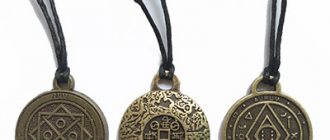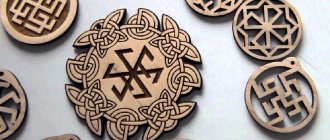In an effort to get an education, a person wants to become more perfect. The study of religion and its symbols contributes to his spiritual growth. People often wonder why God in Hinduism has so many forms and so many different names. In Hinduism, a person comprehends a single divine principle, or Brahman, through its many manifestations. The central theme of Hinduism is the knowledge of God, that is, man’s knowledge of his divine nature, and the symbols of Hinduism have only an auxiliary meaning in this process.
Ohm
The sacred syllable Om is a symbol of Hinduism, helping to comprehend the divine principle. It is always placed before the names of all deities and is pronounced at the beginning of each mantra, enhancing its effect. The sound components of the syllable Om represent the three hypostases of the supreme god - Brahma, Vishnu and Shiva. From the syllable Om arise not only all alphabets, but also all knowledge. The five elements of nature also emerged from this sound.
Gayatri
For Hindus, the most important mantra is the Gayatri mantra, which was first mentioned in the Rig Veda. Goddess Gayatri is the main deity of this mantra, consisting of 24 syllables. The main deity here is Savitar. The supreme being who is the creator of this Universe, the physical sun of our planetary system and the spiritual sun residing in the heart of everyone. Reflecting on Savitar and praying to him to direct our mind to the knowledge of truth is complete surrender to God, thanks to whose grace self-knowledge is possible. Constant repetition of this mantra with maximum concentration on its meaning leads to the knowledge of the transcendental Brahman.
Swastika
The swastika is another common symbol that is often depicted in Hindu temples and in front of altars. It is the emblem of the sun with its rays and symbolizes the sacred fire of truth, which a person must kindle within himself. In addition, the swastika was also considered as a symbol of fertility in Hinduism. The word “swastika” translated means “to do good.” There are two types of swastika - moving clockwise, which indicates creation, and counterclockwise, which indicates destruction. This symbol of Hinduism symbolizes the wheel of the world, which is constantly changing, revolving around an unshakable center - God. Swastika signs depicted on the walls and doors of houses are designed to protect them from both evil spirits and the destructive forces of nature.
Features of Indian beliefs
The ancient Hindus believed that life was controlled by gods who were similar to people, but they had superpowers to subjugate the natural elements. The main deity was the lord of thunder, Indra, along with him the god of the sun, Surya, and the moon, Soma, ruled. The lord of fire Agni also played an important role; he acted as a link between people and gods. Fire was used in many ancient Hindu rituals.
The main deities in Indian culture were called devas, but, in addition to them, there were also asuras, who played a much smaller role and did not particularly influence people's lives.
India is very famous as the country where Vedic teachings originated. Words such as karma and reincarnation are known to everyone, but it was the ancient Vedas who introduced these concepts into everyday life. Almost all world religions believe that the soul is immortal, but only the ancient Hindus believed that it never leaves this world. Death, according to the teachings of the Vedas, is simply a change in form, a transition from one body to another. In order for the next incarnation to be successful, it is necessary to monitor the purity of karma.
Sri Yantra
Another sacred symbol of the Buddhist faith. The Supreme God is represented here by the central point, symbolizing the highest consciousness. Two triangles penetrating each other mean the union of Shiva and Shakti - the balance of static and dynamic energy in the Universe. The 43 triangles formed by the intersection of 9 triangles represent everything that has a ternary nature. Three times - past, present and future. The three states of consciousness are waking, dreaming and deep sleep. The outer circles with 8 and 16 petals, set in a square with breaks on each side, represent certain forces invoked in the process of worship. By worshiping the Sri Yantra through its graphic representation of straight and curved lines, we become one with the Universe, the deities and ultimately with the higher consciousness.
Lotus
The lotus is a symbol of faith in Hinduism, a symbol of purity that cannot be tarnished by surrounding dirt. He personifies spiritual development. The lotus, the most beautiful of flowers, also symbolizes the heart, the most important organ of the human body. A person who worships a deity meditates on his image, placing it in the lotus of the heart - the source of life itself. Lotuses, symbolizing centers of spiritual energy, are found both outside and inside the human body. Hindus believe that there are seven main energy centers in the human body. When spiritual energy awakens in a person, he is able to perform miracles. The awakened energy moves up the spiritual channel along the spine to the crown of the head.
Getting to know the symbols of Hinduism helps spiritually aspiring people to understand the higher reality behind them.
TAJ MAHAL: symbol of fate, symbol of love
“Say: “Truly my Lord has guided me to the straight path, to the right religion, the faith of Ibrahim, true monotheism. After all, he was not one of the polytheists.” Say: “Verily my prayer and my sacrifice (or worship), my life and my death are dedicated to Allah, the Lord of the worlds. He has no comrades. This is what I was ordered to do and I am the first of the Muslims.” (Quran 6:161-163).
This material is the 600th in a row, here on the VO website. It would seem that just now there were 500 of them, and now there are a hundred more... I wanted to give something interesting and unusual. Have you been thinking for a long time what this could be? And then it turned out that after the articles about the Chattorgarh and Kumbhalgarh forts, I was asked to continue the “Indian theme”, and it is simply impossible to continue it and not talk about the Taj Mahal. It’s the same as visiting Moscow and not noticing the Kremlin there. And everything would be fine if the photos for the article were “pulled” from the Internet, even in the “public domain” version. But here the photographs are original. Made in India by a person who was not just there as a tourist, but lives and works there. And here another topic automatically arises... the theme... of Fate. And it so happened that about a year ago I published material on VO about the social elevator, and in the style of a “life story,” that is, a life story. Without any scientific calculations, he simply took the history of his family at the turn of the 19th and 20th centuries and described it. But... one of the VO readers, Dmitry, really complained that the “elevator” theme was not being continued - “but you promised.” And so “the stars aligned” that today it turned out to be possible to connect all these three topics in one material.
It is usually said about the Taj Mahal that it is the “pearl of India”.
And it so happened that there lived in Penza a girl named Sveta. From an ordinary family where my mother was the head. cafeteria, well, my dad also did something like that, she graduated from our university with a degree in computer technology, but... since she didn’t have the appearance of a model, as well as “number six” in certain places, then... she went “just to work.” And not in her specialty, but in a marriage agency, to select couples for marriage on the Internet, since initially she was also good at English. That is, the usual fate of so many ordinary Russian girls of the 90s.
A group of female students from different countries went on vacation to travel around India. Our Svetlana is on the right. Actually, you can’t say that it’s Russian, right? For example, without knowing this, I could say that she comes from Kashmir. There are just one of them!
And then, in order to break out of this routine, she signed up for... an Indian dance ensemble, where she met my daughter, also Svetlana, who danced there and worked as a PR manager, that is, she raised money for him from sponsors for advertising. She started dancing and... things took off for her! And it went so bad that... Svetlana decided to go to Moscow to the Indian embassy, where, as she knew, there was an Indian dance school, after graduating from which she planned to receive a certificate giving the right to teach, open her own studio and work for herself, and not “like your uncle.” There they watched for some time as she mastered the art of Indian dance, and then they accepted and offered... to go to India to one of the largest Indian universities to study with a degree in international marketing. “The training is in English, so this is not a problem for you.” “Yes, but I don’t have...” she began, but they told her: “And we will give you a grant for all five years of study. You will be required to practice it and... learn Hindi.”
Well, now let's go on an excursion to the Taj Mahal mausoleum. But first you will have to wait in line, and a considerable one. The poet truly said very correctly: “The people’s path to him will not be overgrown!”
That’s how our Svetlana ended up in India, where she ended up in a dorm room with three other foreign girls: one was from Kazakhstan, another from Turkmenistan, and the third even came from Madagascar. Naturally, they asked what was the point of recruiting them, foreigners, to study when India has so many talented youth of its own, and the competition is almost 1000 (!) people for one place. “But they don’t know life abroad,” they answered very directly and honestly. “They mostly see white people as sahibs, and it will be many years before they, even having received an education, will be able to work with foreigners on equal terms. But you easily fit into our culture, you understand it well, and it is easier for us to teach you so that you can then immediately work for the benefit of India than to raise our people to your level.”
To get to the Taj Mahal, you need to go through a massive gate, which, according to Muslim tradition, separates the realm of the senses and the realm of the spirit. Visitors entering the garden from the shadow of the gate are greeted by the same mesmerizing sight that first appeared to the eyes of Shah Jahan more than three centuries ago. The calm surface of the pool reflects the ideal symmetry of the marble mausoleum.
That's how Fate brought this girl of ours to India. At first she lived in a dormitory, and in her senior year she rented a room. By the way, she was paid a stipend of $100 a month. For comparison: in India, a high school teacher receives $90 a month and uses this money to support a family of five! Therefore, during the holidays, together with her roommates, she traveled almost all over India. I visited Rajasthan, the temples of Khajuraho, and, of course, saw the famous Taj Mahal.
It's dark and cool inside the gate. And the Taj Mahal is still visible in the distance... The axis of symmetry passes exactly in the middle of the gate of the wall surrounding it and the entrance to the mausoleum itself!
Well, then she received her diploma and... had to stay at work in India. She received a referral to the state of Gujarat. For the construction of India's largest solar station in the middle of the desert as a PR manager for this project with a budget of... one billion dollars! She was also given an appropriate salary, and not by Indian standards, but by European and American standards, so it’s better not to mention the amount. She rented a two-story house with a servant, a cook and a Land Rover, and in her free time began driving it around India. And in all this there was neither our traditional connection, nor family ties, nor big money - just the “smile of Fate”!
The alley that leads to the stylobate on which the mausoleum building is erected is very long and along it there is a reservoir of the same length, in which the mausoleum and its minarets are reflected as if in a huge magic mirror. There are a lot of people here. They come from other countries and from the most remote corners of India.
Yes, this is how the social elevator turned out to be, elevating an ordinary girl from a Russian province to the manager of an international project of colossal value and enormous significance. And it all started with a passion for Indian dances and a good knowledge of English by our Russian standards. So “Lady Luck,” if she really wants to benefit someone, will find you anywhere, even in the office of a marriage agency. It is only necessary that a person be ready to jump on this “restive filly” and stay on her back... And then, then she will take you where you need to go herself!
We are getting closer and closer, and now the wonderful carvings decorating both the stylobate and the walls of the mausoleum become clearly visible to us.
Well, then we will talk about the fate that has marked another person with its stamp. Who lived in ancient times, the son of the Sultan, a powerful ruler, who with his power gave the world the Taj Mahal.
Minarets were built on all four corners of the stylobate. Moreover, they are not straight, but slightly inclined in different directions. So if there was an earthquake here, they would collapse outward, but not inward. To the left and right of the mausoleum are no less beautiful mosque buildings, built of red sandstone.
It is interesting that people who see the Taj Mahal are most struck not so much by its beauty (from a distance it is not too visible!), but by its proportionality, proportionality and the harmony contained in it. And about its symmetry and refinement of forms it can be said that they are like the most perfect pearl created by nature. And this is not only the most famous mausoleum in the world today, but also undoubtedly one of perhaps the most beautiful buildings on earth. It stands on the southern bank of the Jamna River near the city of Agra, and its silhouette is well known all over the world, and for many people it has long been an unofficial symbol of India. However, the Taj Mahal owes its fame not so much to its beautiful architecture, combining majestic simplicity with the grace of precious decoration, but also to the romantic legend that is closely associated with it. After all, this mausoleum was built in the 17th century by the ruler of the Mughal Empire, Shah Jahan, in memory of his beloved wife, whose death plunged him into inconsolable grief.
Here's one of them up close...
According to the tradition in India (or at least people are told that there is such a tradition), when lovers come here, the woman asks her companion: “Do you love me so much that if I die, you will erect a similar monument to me?”
Marble carving on stylobate.
Shah Jahan, nicknamed "Lord of the World" (1592-1666), ruled the Mughal Empire for thirty years, from 1628 to 1658. He patronized the arts and encouraged construction, so that during his reign the empire reached the peak of its political and cultural prosperity. When Shah Jahan was 15 years old, he met Arjumand Vana Begam, the 14-year-old daughter of his father's chief minister. And he not only met, but fell madly in love with her.
Here are their portraits.
Marble carvings and inlays with multi-colored stones decorate the walls of the tomb.
She was both a beautiful and very intelligent girl of very noble origin - and for the prince she could well become a wife. But the young Shah Jahan was expected to marry a Persian princess for political reasons. But fortunately for both of them, Islamic law allows a man to have not one wife, but four. And just like that, in 1612, Shah Jahan was finally able to marry his beloved. Moreover, Shah Jahan and his bride had to wait for this for five whole years, since a favorable combination of stars was required. Do you remember what it was like at Khobja Nasreddin’s place? “The stars of Sad al-Zabih are opposed to the planet Mercury... therefore... it is impossible!” That's how it was in this case. So she got married at the age of 19. The age for marriage for India at that time, one might say, was simply extreme. And all this time they should not have seen each other at all. Another test they passed! Well, then, after the wedding, Arjumand received a new name - Mumtaz Mahal (“chosen one of the palace”), and Taj Mahal is one of the variants of this name.
Amazingly beautiful, isn't it?!
And these inlays too...
Shah Jahan lived with his beloved wife for 19 years, until 1631, when she died in his military camp while giving birth... to his fourteenth child! The ruler's grief was as boundless as his love. He spent eight days locked up in his chambers, mourning his wife, and upon leaving them, he turned gray and hunched over so that the courtiers barely recognized him. He declared mourning in all his domains, prohibited music, wearing bright clothes, jewelry, and even the use of incense and cosmetics. After this, Shah Jahan swore an oath to build his beloved tomb, the likes of which the world had never seen.
The fence containing the tombstones of Shah Jahan and Mumtaz Mahal.
And so the work began, which lasted about twenty-two years. Moreover, the mausoleum building itself was built during the period from 1632 to 1643, that is, surprisingly quickly. Which, however, is not surprising, because more than twenty thousand people worked on the construction. From different parts of India and Asia, lines of elephants walked day and night, transporting building materials. The white marble walls of the mausoleum were inlaid with a variety of gems: jasper and sapphires, agate and turquoise, malachite and carnelian. In total, more than 40 types of stones were used for decoration, which were brought from China, Persia, Afghanistan, Arabia, Sri Lanka, Tibet and even Russia, from where malachite was delivered.
Entrance to the mausoleum.
But the building itself was only part of a simply huge burial complex, which included a huge garden, two mosques, a gate and a huge wall around this entire area. There is an inscription in the Taj Mahal that the construction was completed in 1648, but judging by its volume, even after this time the final finishing work continued for several more years.
All around is polished marble!
It became possible to create such an impressive structure in just over 20 years only because Shah Jahan used the resources of his empire on the construction: in addition to 20,000 workers, as many as 1,000 elephants worked here!
This is what the minaret looks like from below!
The large dome, which is shaped like the bud of an unopened flower, rises up, wonderfully in harmony with the arches and other smaller domes, as well as with four minarets, built so that their tilt to the sides is not at all noticeable to the eye.
Well, this is what the Taj Mahal looks like when you look at it from behind.
If you stand with your back to it, you will have a view of the river that flows right behind the mausoleum.
From the outside, the Taj Mahal surprises everyone with its perfect symmetry, but inside it is simply impossible not to admire its mosaic patterns on the walls. The main place inside is occupied by an octagonal room, surrounded by an openwork marble fence, which was previously inlaid with precious stones. There are tombstones of Shah Jahan and his wife. Moreover, her tombstone is again located symmetrically, but it is not there.
The tomb of Shah Jahan, which is located slightly to the side of the mausoleum, located along the axis of symmetry of the tomb of Mumtaz Mahal, is the only element in this mausoleum that breaks this symmetry.
Having completed the construction, Shah Jahan wished to build a similar tomb on the opposite bank of the Jumna, but only from black marble and to connect both mausoleums with a bridge - a symbol of their love, which survives death itself. However, in 1657, before work began, Shah Jahan fell ill. Well, a year later, what happened to him was what happened to many rulers before him: his son Aurangzeb got tired of his father’s building eccentricities, and he overthrew him from the throne to rule himself!
Peacocks and pronghorn antelopes roam the park.
This is how the park and the mosques surrounding the mausoleum look in the approaching twilight...
True, he still did not dare to kill his father. I probably wanted to. But he didn’t dare. He was kept in captivity, but where is exactly unknown. But it is known for sure that after his death in 1666, Shah Jahan was buried in the Taj Mahal, next to his beloved wife, whose love prompted him to create this marvelous architectural masterpiece.
Of course, we can’t do without monkeys here either...
After the fall of the Mughal Empire in the 18th century, the Taj Mahal gradually fell into disrepair.
A snake tamer is a profession in India as common as the profession of a kvass seller in our country.
In the 19th century it became a place for receptions. Well, the Taj Mahal was restored to its former glory as a result of efforts undertaken by the British Lord Curzon, Viceroy of India from 1898 to 1905, and a staunch supporter of the revival of Indian antiquities.
The entire history of the Taj Mahal is written here...
Well, the journey of “our girls” continued after that and, having visited the Taj Mahal, they went to Rajasthan or ancient Rajputana - the sun-scorched land of ancient Hindu knights...
Ganesha
Worship of the god Ganesha is present in all directions of Hinduism. Since he has the power to remove all obstacles, he is worshiped before starting any work. Followers of Ganapati believe that Om as a symbol of God is embodied in the form of Ganesha. Behind the sound Om, which generates the entire Universe, Ganesha appeared in the light of the first dawn. Ganesha then called upon Brahma, Vishnu and Shiva to perform the functions of creation, maintenance and destruction of the Universe through the perfection and wisdom with which he endowed them. In addition to the ecological explanation of the images and attributes of Ganesha, the symbolism contained in his image carries deep philosophical truths. The most striking feature of Ganesha is his huge body, symbolizing the Universe.
The Elephant's head symbolizes good beginnings, courage and the power of intellect. Ganesha's large ears are like baskets that seem to sift the wheat from the chaff in order to convey the truth to the worshipers of God. The ears also indicate the ability to listen. Physical truths can only be comprehended by sitting at the feet of a teacher and listening to his words. The wisdom needed to understand the truth is symbolized by the large head of Ganesha. The deity is usually depicted with four arms. One hand makes a gesture of blessing. In the other he holds a sweet, symbolizing the sweetness of man's knowledge of his nature. In the third hand there is a semicircular hatchet, and in the fourth there is a lasso.
Natural stones as amulets and talismans
India is very rich in stones created by the hands of nature itself, from which you can make an Indian talisman with your own hands. Moonstone is very popular. For hundreds of years, Hindus have been trying to wear jewelry or complement their outfit with a moonstone, which symbolizes health and is also able to protect its owner from negativity.
Aquamarine beads or bracelets will give the owner courage and self-confidence.
Good communication and making friends will be given by topaz, which the Indians have endowed with the appropriate abilities. Another unique stone is considered to be aventurine, which was used many centuries ago by snake tamers. Each person will be able to choose their own personal stone, depending on their needs.











